The Intel Core i7-12700K and Core i5-12600K Review: High Performance For the Mid-Range
by Gavin Bonshor on March 29, 2022 8:00 AM ESTCPU Benchmark Performance: Power, Office, and Science
Our previous set of ‘office’ benchmarks have often been a mix of science and synthetics, so this time we wanted to keep our office section purely on real-world performance.
For the remainder of the testing in this review of the Core i7-12700K and i5-12600K, we are using DDR5 memory at the following settings:
- DDR5-4800(B) CL40
Power
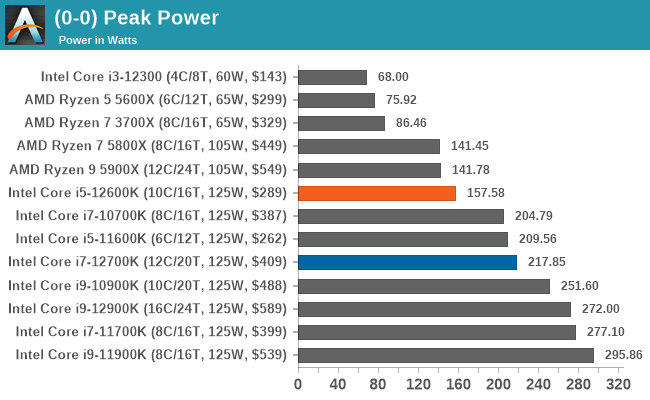
Comparing power draw to other competing CPUs, both the Core i7-12700K and Core i5-12600K are noticeably more power-efficient than previous generations including both Intel's 11th Gen and 10th Gen Core. Though at full-load with no overclocking, AMD's Ryzen 5000 and 3000 series processors remain much more power-efficient.
Office
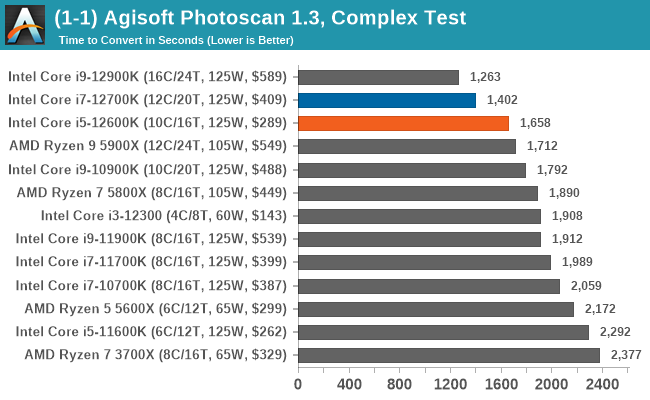
In our office benchmarks, Intel's 12th Gen Core reigns supreme in Agisoft Photoscan due to its higher core frequency and IPC performance.
Science
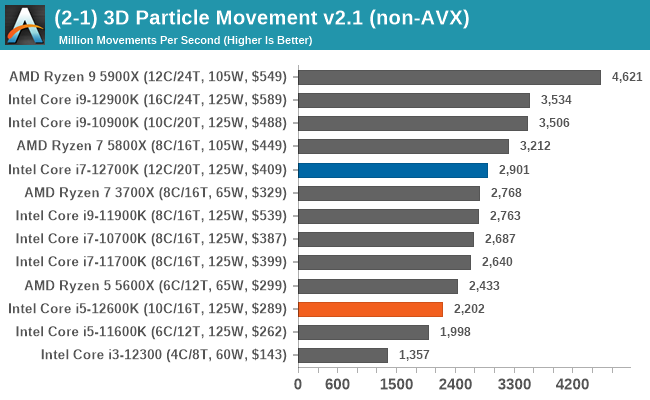
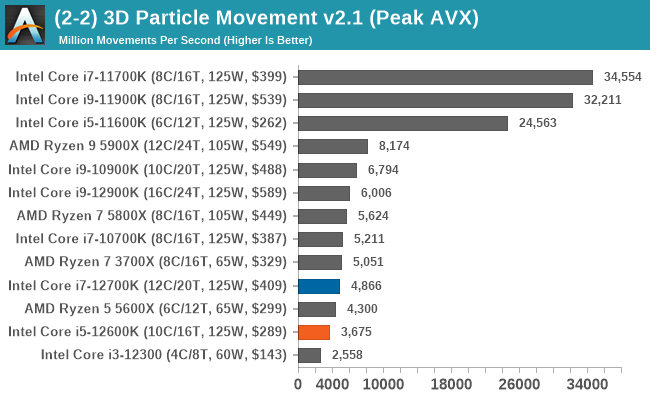

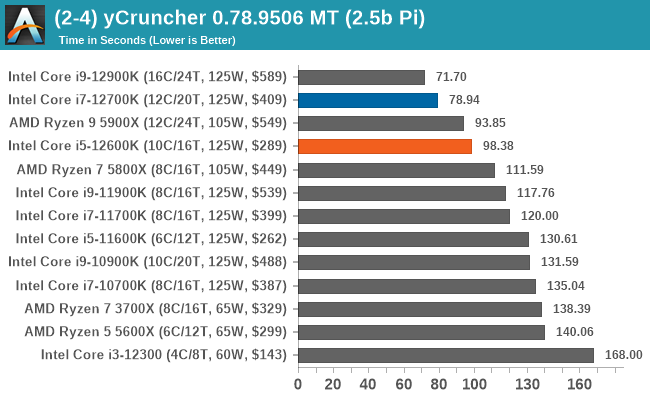
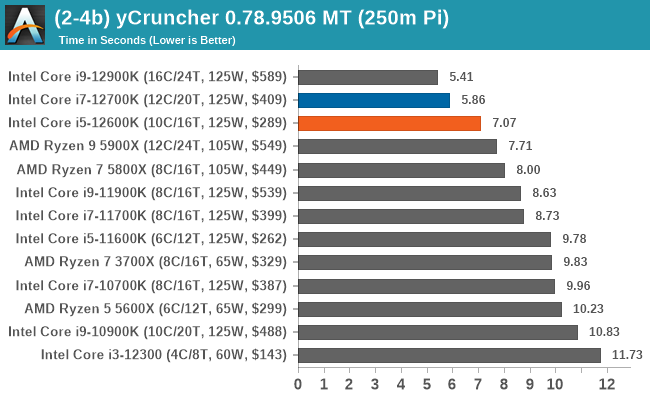
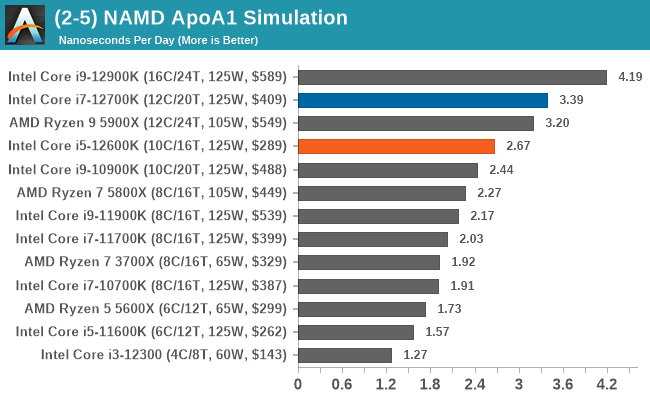
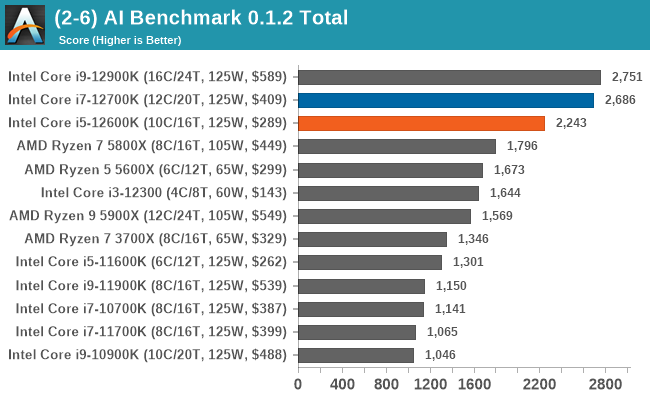
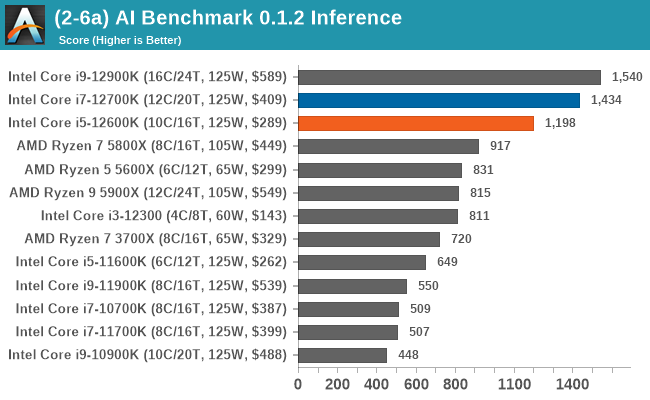
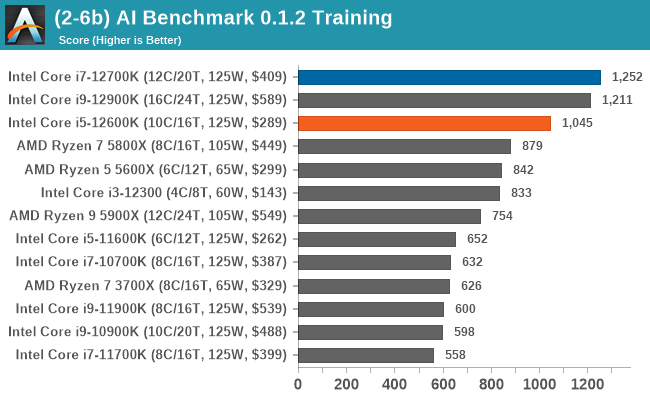
In the majority of our science-based benchmarks, both the Core i7 and Core i5 did well. The only benchmarks that didn't favor the 12th Gen Core series processors were in 3DPM 2.1, but more specifically in the AVX test.










196 Comments
View All Comments
Qasar - Wednesday, April 6, 2022 - link
mykebrazone,"then is Jon Peddie Research a source, Mercury Research, IDC, Gartner, Canalysis none can show their data or work. I'm the only one who shows my data and proof of work.
My data is from ebay, seller offers, I do the same job people ldo inside AMD, Intel and Nvidia keeping track of channel supply volume that can be directly applied to micro production economic assessment and is used by AMD, Intel, Nvidia primarily for channel sales management. "
then post a link to those sources, so any one else can click the link and see that data for them self.
"I'm the only one who shows my data and proof of work. " um no you dont, at least not on here, and with out sources that show that same data, that we can also compare to, for all we know, you are making it up.
"If my site is not a source then " no its not, why ? because, as i said above, you have no link to the original info that you are compiling your " info " from. sure you say you are getting if from Jon Peddie Research a source, Mercury Research, IDC, etc, but with out links to the SAME info, you could be making it up.
"from your perspective, neither is JPR, Mercury, IDC, Gartner, Canalysis, Micro Design Resources, published of Microprocessor Report, not a source? " they are sources, but YOU dont link to those sources here, OR on your site, so again, it looks like you are making it all up,. aka fluff
look, sorry if i insulted you and your are hurt, but the bottom line is this, so far, your posts come across as made up fluff, ONLY because you dont also include links to that SAME data, so others can compare, or come to the same conclusions. you include numbers, and other data, that also can't be confirmed or verified, that is the point i am trying to make, just like a reporter reporting on the news, if the reporter cant confirm or verify if the info is correct, and still goes on air, and reports it, and it is wrong, how would that reporter look ?
" Sorry to joust with you. Please define source? " if you dont know what " post a link for your sources is, then i cant help you, and you should find another line of work.
Mike Bruzzone - Thursday, April 7, 2022 - link
@Qusar, the supply wave forms I post on SA, from ebay channel offers, highly checked to remove duplication, is the data.That data provides a foundation for micro production analytics, total revenue total cost modeling
which backs out cost from revenue to get to marginal and hard cost. The data is also good for device yield, frequency and power plots.
The primary tool I rely was promoted by Intel parallel Xeon Tanner, I joke it came loaded, who trained the financial analyst community how to use that tool 1996 through 2001 which on Intel input from a transmission system called supply signal cipher, could be relied to calculate Intel revenue and margin up to eight quarters into future time. The transmission system was finally shut down through Docket 9341 remedial press on its SEC violation in 2016, And eBay data began to replace it is early as 2012. This industrial management tool for channel supply management and production economic assessment is now primarily based on eBay offer data.
The tool in the industry analyst community was first administered by Jim McGregor of Trias when he was at Microprocessor Report. Kevin Krewell may also have attempted use of the tool set which are date base and spreadsheets formulas.
I inherited the base MDR 1996 to 2000 data directly obtained from Intel, given to me by Linley Gwennap, when MDR decided too no longer to do this specific Total Revenue Total Cost analysis on the SEC violation back in the late 1990s. I have added to that Intel/MDR originating data 22 years of data, and recently just released some to a You Tube CS / quasi economist goes under the name of TechLens to see if he would do anything productive with it.
Like I said go to Seeking Alpha, see the data in (supply) wave forms, and if something strikes you as interesting let me know and I'll offer you an assignment where you can hold some of the data.
mb
Qasar - Saturday, April 9, 2022 - link
what ever mykebrazone, all you posted was blah blah blah blah blah, lots of text that looks more like you typed it out to just confuse people, that comes across as you are dunk. and, SURPRISE NO direct links to your sources, data OR info where you came up with this BS. not going to your webpage, so you can get more page hits any more, the times i have, there have been no links to your sources, as usual, again just more fluff and what looks and sounds like made up crap, no thanksMike Bruzzone - Sunday, April 3, 2022 - link
@ballsystemlordParticipating in Intel Inside is an Intel primary OEM contractual requirement.
Intel Inside was discontinued entering 2019. I am the original relator witness source of Intel Inside relied as price fix including to Federal Trade Commission, the California and New York Departments of Justice from 1991 through 1998 employed by Cyrix, ARM, NexGen, AMD and IDT Centaur.
In 1997 Intel hired me to consult on my in-field antitrust observations across North America and that consultancy went poorly, I was thrown under the bus lead by Dr. Andy Grove, his corporate detectives and legal fixers a curse I still am in court over today. There is not an Intel CEO I have not confronted as a federal and states witness. I was enlisted by FTC attorneys in May 1998 and continue today as FTC v intel Docket 9341 consent order monitor. I am contracted by USDOJ to recover Intel Inside price fix for the federal government and retained by Congress "for the people" to do same at Constitution 9th amendment. In this capacity I'm the expert for 82 plaintiff actions.
Charlie Demerjian from Semi Accurate has said an Intel Inside like system of 'brand fee rewards' which is my term, still exists associated with the Evo mobile marketing program and I am unsure on discontinuation of the overall Intel Inside program entering 2019.
Q; "Intel gives a rebate for using their CPUs in designs, but only if the OEMs sell them? Then the retailers also get a rebate on the sale of the product?"
A; All processors leaving Intel are charged with the Intel Inside cost of this brand fee reward monopolized by first tier OEMs.. All Intel Inside payments end up at the end buyer sales outlet whether that is an OEM selling direct through a PC media site, in which case the OEM pockets its own Intel Inside 'rebated fee accruals plus the Intel match makes the OEM some extra cash. And if not an OEM direct sale, through the reseller channel, the OEM regulating one half and the Intel matching one half of this two value tie cost : charge are both paid by Intel to the end seller. First half from OEM's existing pool of rebate debits from Intel processor purchases that debit to OEM accrual averages around 4.6% of the processor purchase price from intel; passed on to the end buyer in CPU and CPU in PC cost to administer sale out inventory reporting to Intel. Where thereafter Intel issues a credit from the OEM accrual to issue a payment to the end seller that Intel matches credited as a cost of Intel marketing. For most of Intel Inside's 28 years that money went primarily to OEM direct sellers, to PC media, broadcast media or PC retail sellers. Intel Inside paid for a large portion of the operating costs of PC tech press 1993 through 2005. Name the hard copy computer magazine or computer web publisher review site and Intel Inside was a major source of revenue if not the majority of revenue from all sources Intel + first tier OEMs.
Q; "Intel doubles production of CPUs every year. How do they get rid of them all?
A; Intel sells to first tier OEMS in sales packages that are a bundle of Xeon, Core desktop, Core mobile, Atom and can include their associated control hubs, NIC and non volatile memory and way back when included the Intel mainboard and could include kit DRAM. No doubt Arc GPU will be sold to OEMs in CPU + GPU kit bundle.
Q; "Intel doubles production of CPUs every year."
A; No, Intel produces aiming to sell twice or better the real time computer demand. Means to earn at least x2 revenue over organic revenue in any period. Includes surplus processor production greater than real time (immediate) computer demand that 1st Tier OEMs resell (processors they bought for resale to lower their own purchase cost, don't need, don't want or cant sell quickly in a computer) are resold to brokers, second tier integrators, who attach to associated mainboard that may be sold well into the future even after any one generation of processors are EOL'd
A; Good question on the double processor every year question so I did the math. Over 29 years 1993 through 2021 Intel annual processor volume if you believe the commercial analyst; Canalysi, Gartner, IDC annual volume statements, and I do not they severely understate Xeon, Intel total annual volume grows on average 9% per year. Revenue growth on average same period also 9%.
On commercial analysts Intel total processor volume 1993 through 2021 = 5.539,406,562 units. However, that's annual desktop and mobile volume that misses Xeon. For example between 2017 and 2019 Intel sold approximately 1,511,873,730 units of v2/3/4 that are produced simultaneously through that two year period dependent what platform generation the customer had standardized on. Xeon Skylake and Cascade Lakes are another 400M units produced. IDC so said 20 M annual servers is disinformation to conceal the actual Xeon production volume. Specific Skylake and Cascade Lakes, 400,000,000 processors over the full run / 18 processors per rack = 22.2 M racks of servers.
Q; "How do they get rid of them all?"
A; Intel gives them away, what first tier OEMs don't want or won't buy. No OEM pays for most of i5, all for i3/P&C/Atom. They're thrown in as sales close incentive. For the first tier also includes large amounts of Xeon thrown into first tier OEM sale's packages at, and can be below, Intel cost dependent how fast Intel wants to move overage out of Intel and into sales channels. Eventually seeding the market like this comes back to Intel, and AMD now too, and even ARM, funding the channel with processors bundled into sales packages is a method of capital creation for a cost to Intel but free to channels. Intel calls it social welfare value. OEMs and upper echelon of channel earn on system sales incorporating Intel 'surplus' processors secured for little or nothing. And then that margin eventually comes back to Intel on new channel procurements. Grows the total available market on this method of industry capital creation.
Now the unnecessary social welfare value (raising cost) which may be the subject of Intel's 30% cost optimization on AMD cleaning up this costly practice in 2021. That is the amount of revenue supplied in 'free' product and in this example sacrificed to hold the first-tier customer account; contract after sales contract. The amount of bundle deal thrown into every customer purchase.
Recall AMD complaining in EUCC 37.990 about Intel giving the last 10% of processors in any sales contract away? Essentially free although Intel cost : price averages them within any one contract. Currently, Intel may even provide Ice for free if the buyer guarantees a Sapphire rapids procurement in this 'contract tie' example. AMD can do this into future contract tying too, but I'm not aware of anything directly and its primarily associated when one generation of product is sub standard moving to the next generation. Intel sales calls sub standard "kibble" and "dog food" just good enough product like Xeon Skylake; does the job, keeps business humming along and available in volume. Rest assured AMD is not beyond the same sales techniques as Intel when product is equally matched. However, on rising production costs both appeal much more focused on optimizing 'unnecessary avoidable costs" out of their business, marketing and sales structure.
Q; "If that was working, why did they switch to demand based production for Ice and Alder Lake?
A; Surplus has a manufacturing cost. Eliminating overage, not producing surplus, returns that cost to the bottom line.
A; Specific Ice, a run end product customers are waiting for Sapphire Rapids so why overproduce Ice? Surplus delivers a cost add whether to Intel or channels caught holding surplus, then having to discount including bundle deals, the channel bundles too; good gets thrown in with not so good and that's becomes a prerequisite of the volume sales procurement; take it or leave it. Or, take want you want at a much higher price leaving the surplus resale opportunity off the table. The question with surplus traditionally is can I wrap the cost of a PC around it those 'free sales reward' processors, often end run product, and still make my target margin in return,
Here's the federal and States academic orientation on Intel Inside I represent 27 known States AG;
https://seekingalpha.com/instablog/5030701-mike-br...
mb
Mike Bruzzone - Sunday, April 3, 2022 - link
Clarification -Or, take want you want at a much higher price leaving the surplus resale opportunity OFF THE TABLE. Whoops in this example of not taking the surplus in the BUNDLE DEAL, leaves that surplus ON THE TABLE and out of the procurement, not taking the risk of holding overage. If you only buy the processors you want, for integration into a PC sold quickly, you pay more. Take the surplus in a bundle deal price and you might pay less overall IF you can resell that overage in that sales package for a profit margin. mb
Mike Bruzzone - Sunday, April 3, 2022 - link
And a note, I'm here auditor and monitor. The information and data I glean here, from you, and anywhere you see me commenting including tech tube is relied for channel supply assessment.Channel supply assessment is important. Understanding what will and will not sell. Primarily to prevent, on inventory sales management, to mitigate channel getting stuck with rotten tomatoes, CPU surplus and overage that takes from industry active capital funding primary production. That can be as it was in the past, 2001, 2005, 2007/08, destroyed on purpose by Intel to take back cartel price making control from open market channel. By prematurely obsoleting channel held industry accumulated capital values, processor and systems. Intel was about to try that in 2019 and refrained. mb
ballsystemlord - Monday, April 4, 2022 - link
Thanks for getting back to me. I understand now.Mike Bruzzone - Monday, April 4, 2022 - link
@ballsystemlord, you're welcome. mbMakste - Friday, April 22, 2022 - link
Jesus ChristKhanan - Sunday, April 3, 2022 - link
I want to add one thing to that as well: if Intel returns into a dominating position, as they are already a too strong company it will again just suffocate the market and options for PC users. Anyone who is interested in good technology should oppose Intel being as strong as before and hope AMD stays on pole position.Despite Intel being on the back foot for years now, they had a strong control over the market, we don’t need Intel to be completely dominating it again, they will be strong enough anyway. Better is if Intel loses more share of the market to AMD so it evens out at about 50% each, that would be great.